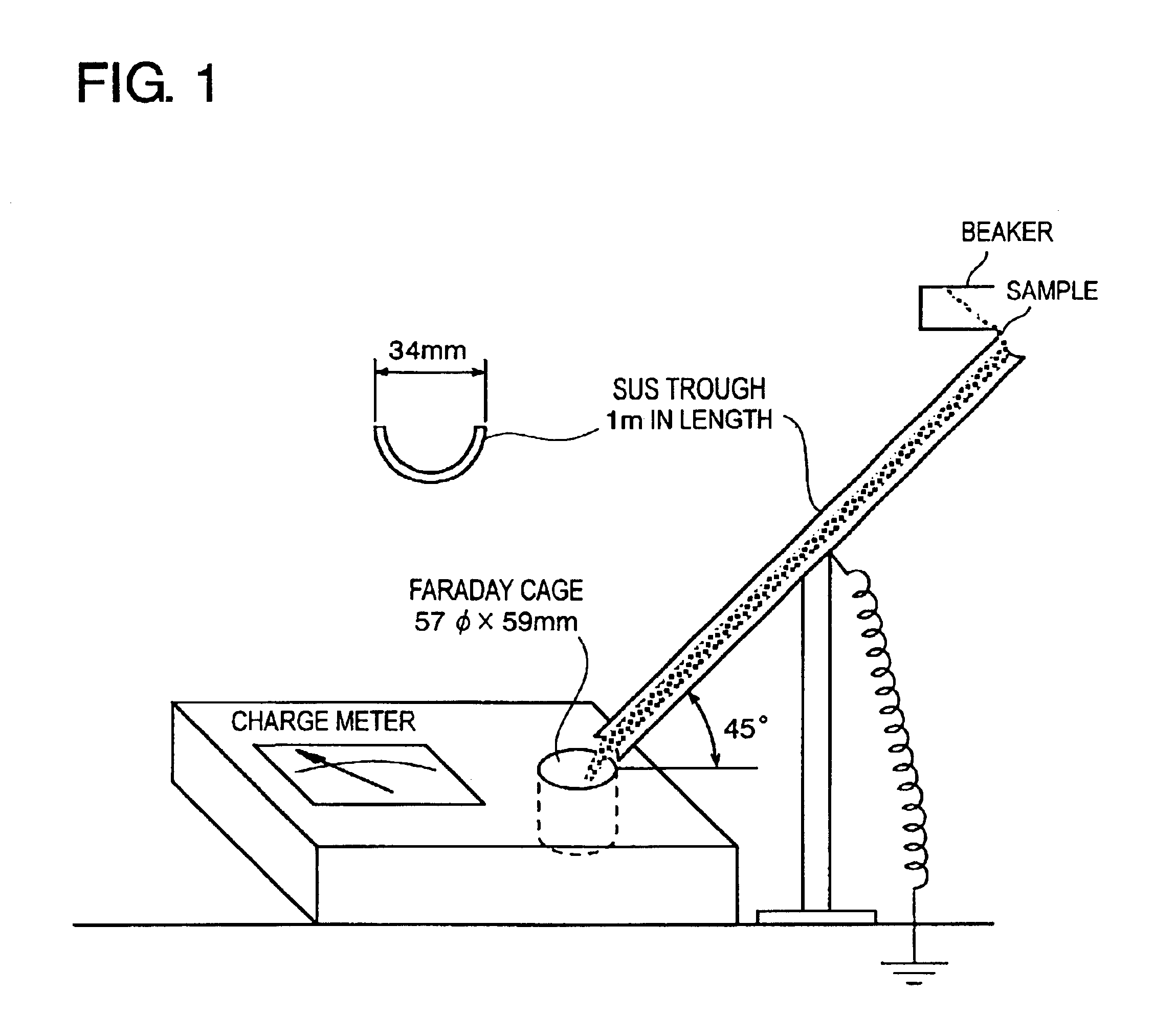Zinc acrylate particle composition, method for production thereof, and golf ball using the composition
a technology of zinc acrylate and composition, which is applied in the direction of non-metal conductors, conductors, sport apparatuses, etc., can solve the problems of deteriorating workability, affecting the relevant device, and reducing yield, so as to achieve low electrical chargeability, not easily scattered, and easy handling
- Summary
- Abstract
- Description
- Claims
- Application Information
AI Technical Summary
Benefits of technology
Problems solved by technology
Method used
Image
Examples
example 1
[0069]A jacketed kneader having an inner volume of 5 liters was charged with 2386 g of toluene and 4.5 g of an anionic surfactant (content of active component 70% by mass; made by Kao Corporation and marketed under the trademark designation of “Pelex OT-P”). Then, the resultant mixed solution and 570 g of zinc oxide added thereto were stirred together to prepare a suspension. With the internal temperature of the kneader maintained at 40° C., a solution of 140 g of stearic acid as a higher fatty acid in 490 g of toluene was added to the resultant suspension over a period of one hour to obtain a suspension, which was then left reacting additionally for two hours.
[0070]Subsequently, after the internal temperature of the kneader had been cooled to 15° C., the suspension therein and 999 g of acrylic acid added gradually thereto over a period of three hours so as to reach 35° C. were left reacting at 40° C. for four hours. While the resultant reaction suspension was gradually heated to 50...
example 2
[0075]By repeating the procedure of Example 1 while changing the amounts of the anionic surfactant and the acrylic acid respectively to 4.6 g and 982 g and using 207 g of stearic acid as a higher fatty acid dissolved in 725 g of toluene, 1,600 g of zinc acrylate particles containing 0.2% by mass of the anionic surfactant and 14.3% by mass of zinc stearate was obtained.
[0076]Then, the zinc acrylate particles thus obtained were pulverized in the same manner as in Example 1, to obtain a zinc acrylate particle composition containing aggregates measuring not more than 1 mm in particle size.
[0077]When the zinc acrylate in the zinc acrylate particle composition which had been thus pulverized and classified was measured for the median of particle sizes by the dry type method and the wet type method, the medians of particle sizes as determined by the dry type method and the median of particle sizes determined by the wet type method were found to be 89.6 μm and 4.7 μm, respectively. Thus, the...
example 3
[0080]By following the procedure of Example 1, 1,553 g of zinc acrylate particles containing 0.2% by mass of an anionic surfactant and 10% by mass of zinc stearate was obtained.
[0081]Then, by pulverizing the zinc acrylate particles obtained as described above in the same manner as in Example 1 and classifying the pulverized zinc acrylate particles by following the procedure of Example 1 while using a screen having an aperture of 3 mm in place of the screen having an aperture of 1 mm, a zinc acrylate particle composition containing aggregates of not more than 3 mm in particle size was obtained.
[0082]When the zinc acrylate in the zinc acrylate particle composition which had been thus pulverized and classified was measured for the median of particle sizes by the dry type method and the wet type method, the medians of particle sizes determined by the dry type method and the median of particle sizes determined by the wet type method were found to be 119.0 μm and 6.0 μm, respectively. Thu...
PUM
| Property | Measurement | Unit |
|---|---|---|
| sizes | aaaaa | aaaaa |
| particle size | aaaaa | aaaaa |
| particle sizes | aaaaa | aaaaa |
Abstract
Description
Claims
Application Information
 Login to View More
Login to View More - R&D
- Intellectual Property
- Life Sciences
- Materials
- Tech Scout
- Unparalleled Data Quality
- Higher Quality Content
- 60% Fewer Hallucinations
Browse by: Latest US Patents, China's latest patents, Technical Efficacy Thesaurus, Application Domain, Technology Topic, Popular Technical Reports.
© 2025 PatSnap. All rights reserved.Legal|Privacy policy|Modern Slavery Act Transparency Statement|Sitemap|About US| Contact US: help@patsnap.com

